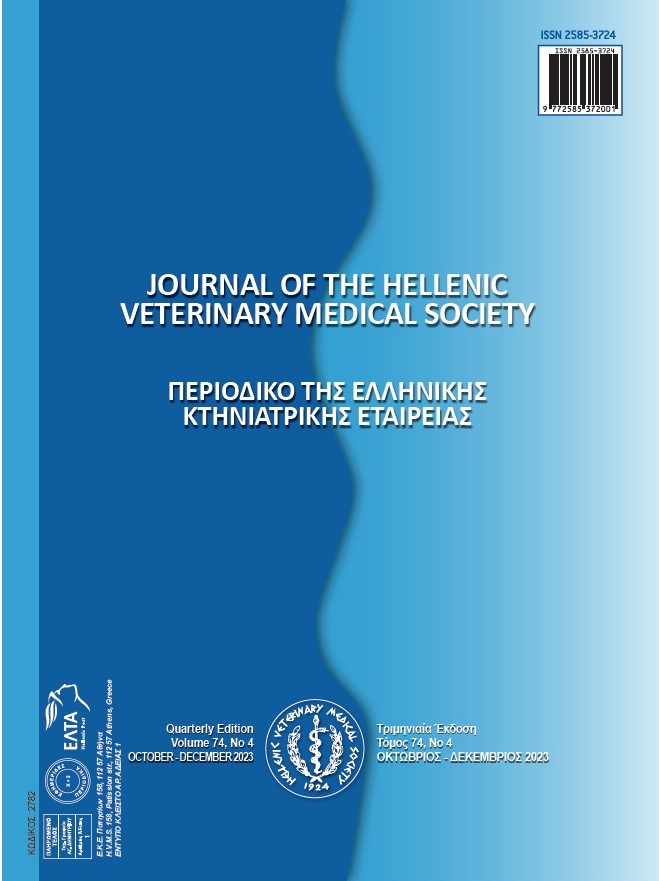Effect of Fluid Therapy and Oxygen Application on Venous Blood Parameters of Diarrheic Calves with Hyperkalemia

Abstract
The purpose of this study was to evaluate the effect of oxygen therapy on clinical, hematological, biochemical and venous blood gases in diarrheic calves with hyperkalemia in addition to routine diarrhea and fluid-electrolyte therapy. Animal material was consisted of 20 diarrheic and hyperkalemic calves, with different ages. Diarrheic calves with serum potassium levels greater than 6 mmol/L were included in the study following the clinical examination and analysis results. The calves were divided into 2 groups. Calves in the 1st Group (n=10) received routine diarrhea and fluid-electrolyte treatment and calves in the 2nd Group (n=10) received routine diarrhea and fluid-electrolyte treatment as well as oxygen applications by mask. Blood samples were taken from the animals for blood gases, hematological and biochemical analyses. The decrease in heart and respiratory rate was more significant in the 2nd group when compared to the 1st group. When statistically comparing the same time periods of both two groups, heart rates were lower in the oxygen applied group and this decrease was statistically significant. In the 2nd group; decrease in WBC, Lym, RBC, Hct%, Hb, MCH, MCHC and MCV levels and increase in Neu and THR levels were statistically significant. Increase in pH, PO2, sO2, Na, Cl, cHCO3 and decrease in pCO2, K, Lac, cBaseEcf and AnionGap were detected. When comparing the same time period of 1st and 2nd groups, there was statistically significant differences were determined on the 5th hour in K, on the 24th hour in pH and pO2 values. Particularly in the oxygen applied group; there were statistically significant alterations in pH, pCO2, pO2, sO2, K and Lac. Among biochemical parameters; decrease in LDH and TP in the 2nd group, and decrease in TP and ALB in the 1st group were found to be statistically significant. As a result, oxygen administration in addition to routine diarrhea treatment is thought to have positive effects on pH, pO2, pCO2, sO2, K. Based on the results obtained in this study, it was concluded that oxygen therapy would be beneficial for calves with diarrhea and hyperkalemia. It is believed that this study will lead to future studies on calves with diarrhea and will shed light on these studies.
Article Details
- Come citare
-
Özbek, M., Özkan, C., & Altan, Y. (2024). Effect of Fluid Therapy and Oxygen Application on Venous Blood Parameters of Diarrheic Calves with Hyperkalemia. Journal of the Hellenic Veterinary Medical Society, 75(1). https://doi.org/10.12681/jhvms.30370
- Fascicolo
- V. 75 N. 1 (2024)
- Sezione
- Research Articles

Questo lavoro è fornito con la licenza Creative Commons Attribuzione - Non commerciale 4.0 Internazionale.
Authors who publish with this journal agree to the following terms:
· Authors retain copyright and grant the journal right of first publication with the work simultaneously licensed under a Creative Commons Attribution Non-Commercial License that allows others to share the work with an acknowledgement of the work's authorship and initial publication in this journal.
· Authors are able to enter into separate, additional contractual arrangements for the non-exclusive distribution of the journal's published version of the work (e.g. post it to an institutional repository or publish it in a book), with an acknowledgement of its initial publication in this journal.
· Authors are permitted and encouraged to post their work online (preferably in institutional repositories or on their website) prior to and during the submission process, as it can lead to productive exchanges, as well as earlier and greater citation of published work.




